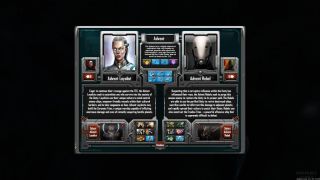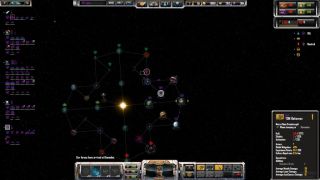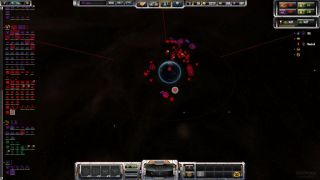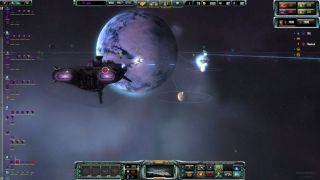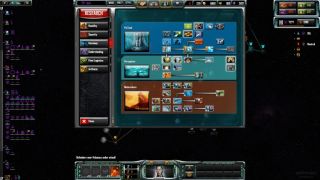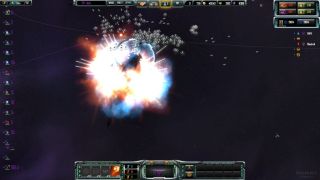I only have normal, early game frigates and one capital ship, the Kol Battleship that has long served as the art that promotes Sins of a Solar Empire. But I know that the pirates I am facing are no match for me, especially if I am able to draw their fire with my big vessel and screen the others in the process.
This system is the first one I conquer and I can already see the possibilities opening up before me: crystal and ore to fuel my economy and my research, space to deploy labs or trade ports to increase my income, areas where I can build more fleets, including the Titan, a planet that might hold one of the rare artifacts that increase my power.
Sins of a Solar Empire – Rebellion, developed by Ironclad Games and published by Stardock, is a standalone release that re-imagines the 2008 space-based real-time strategy game and opens up a horizon of possibility that any fan of the genre will be pleased to explore.
Gameplay
Sins of a Solar Empire – Rebellion is a space-based real-time strategy, meaning that gamers control everything from research, diplomacy, star system development to movement of fleets and, finally, the tactics that help win or lose battles.
The core structure is the same as that of the original release that happened in 2008, which means that the early game of Sins is mainly a question of exploration and quick home system development, with the players scrambling to put together an infrastructure to help their future war efforts and decide which tech trees they will focus on and how they will use their special units.
The middle game consists of a series of defensive battles and offensive probes, as frontlines gradually settle down and each player tries to get his best units out of the factories while making sure that he has the best mix of economics and research to power the coming endgame battles.
It’s important to make sure that one uses the right units for the job and that, rather than trying to discover the entire tech tree, players make solid choices that improve their units in the field and create even more resources in the long term.
The endgame for Sins of a Solar Empire morphs the entire game and shifts the perspective towards the tactical space engagements.
The economy and the tech is pretty much set and solid use of tactics, appropriate tasks for groups of units and solid wielding for the capital ships and Titan is the main recipe for victory.
Usually, getting there involves a few big engagements that are normally too close to call and then a long mopping-up period, mostly linked to dealing with system defenses and then planet bombardment.
The Rebellion release twists all sections of the game and makes the first two of them more exciting while adding a bunch of options that eliminate of the drudgery and the time waste associated with the last one.
There are now six factions and there are many differences between them, offering one suitable for any kind of playstyle, from cautious turtle to raider and conquest obsessive.
There are more victory conditions to enable in order to add variety to the entire game and make sure that starting positions and luck play even less of a factor in who ends up on top of the pile.
There are new units to use, specifically designed to counter some of the most popular tactics of the original, and new technologies inserted into the trees of all the factions, bolstering their own strengths or mitigating their vulnerabilities.
The first release of Sins of a Solar Empire was almost too warfare-oriented for my liking and Rebellion almost swings to the other end of the spectrum, pretty much forcing gamers to interact with the other powers, especially in matches with more than 3 opponents.
This is, in many ways, an entirely new game, although at times the added content baffled me and it took a few games with each of the factions to adjust my tactics.
Solid use of the capital ships, and especially the Titan, is more important than ever, on par with creating a balanced fleet that has both long-range and close quarter assault possibilities.
One problem is that planets seem somewhat more vulnerable and it’s much too easy to simply attack them with capital ships and ignore Siege Frigates altogether.
The Artificial Intelligence – which was very competent in the original release, especially on higher difficulty – seems a little bit easier to overcome in Rebellion (my previous experience with Sins might be having an impact), but it still manages to pull some surprising moves, bypassing strong points and using fleet composition to gain advantages in surprising places.
Also, as a general advice, don’t be afraid to speed up Sins of a Solar Empire as long as you seem to have everything in your game space under control, but remember (as I often don’t) that you can also slow it down again when there’s too much to deal at once.
Graphics and audio
Sins of a Solar Empire was impressive when it was originally launched, giving players who were willing to zoom in a splendid spectacle of ship-to-ship violence, with simple and elegant movement, well-simulated starships and a lot of particle effects.
Despite the four years that have passed since then, Rebellion manages to keep the standard up and there are more details on the ships, better effects when huge battles take place and there’s a nice coat of polish thrown over the entire look of the game.
It doesn’t all seem as groundbreaking as in 2008, yet this is still one of the more lavish graphics experiences available for real-time strategy gamers.
When it comes to sound design, things are a little less rose-colored for Sins of a Solar Empire, especially referring to music.
The score is inspirational and somewhat interesting, but it lacks any real punch and tends to shift gears too much, especially for the player who, like me, tends to quickly shift between sectors that are entirely peaceful and those where battle is engaged.
I like what the development team has tried to do with the voice work, adding a bit of factional personality and some interesting catchphrases to the units, making them endearing at first.
But for long-term players, the feeling wears thin pretty quickly and I have personally taken to playing Sins of a Solar Empire with the sound turned down all the way, listening to my favorite current albums (it helps the space opera feeling to put in some progressive rock).
Sins of a Solar Empire – Rebellion will certainly let some long-term fans down in a way because it fails to deliver any sort of radical re-imagining of the real-time strategy formula, instead focusing more on tweaking and adding to it in significant ways.
Multiplayer
Sins of a Solar Empire – Rebellion allows for both Internet and LAN-based multiplayer and the options for game setup are pretty much the same as for a single-player match with the computer.
As always, the personality of the other humans engaged in the game matters a lot, especially when enabling alliances and when there are 6 or more players fighting for the same solar systems.
When all the engaged gamers are moderately adept at playing Sins of a Solar Empire, solid teamwork and complementary ship composition tend to win the day.
Ironclad Games has managed to once again deliver a game that has no rival in the space-based real-time strategy world and a universe that will end up occupying hundreds of hours of my playing time over the coming months.
The Good
The Bad
Conclusion
 14 DAY TRIAL //
14 DAY TRIAL // 
